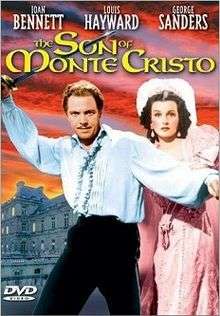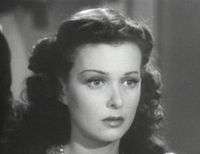The Son of Monte Cristo
| The Son of Monte Cristo | |
|---|---|
 | |
| Directed by | Rowland V. Lee |
| Produced by | Edward Small |
| Written by | George Bruce |
| Starring | |
| Music by | Edward Ward |
| Cinematography | George Robinson |
| Edited by | Arthur Roberts |
Production company |
Edward Small Productions |
| Distributed by | United Artists |
Release dates |
(United States)[1] |
Running time | 102 minutes |
| Country | United States |
| Language | English |
| Box office | 2,213,068 admissions (France, 1946)[3] |
The Son of Monte Cristo is a 1940 American adventure film produced by Edward Small, directed by Rowland V. Lee and starring Louis Hayward, Joan Bennett, and George Sanders. The Small production uses the same sets, and many of the same cast and production crew as his previous year's production of The Man in the Iron Mask.[4]
The film takes the same name as the unofficial sequel to The Count of Monte Cristo, namely The Son of Monte Cristo, written by Jules Lermina in 1881.
Using elements from several romantic swashbucklers of the time such as The Prisoner of Zenda and The Mark of Zorro the production also mirrors the situation of Continental Europe in 1939–1940.
Plot
In 1865, the proletarian General Gurko Lanen (George Sanders ) becomes the behind-the-scenes dictator of the Grand Duchy of Lichtenburg located in the Balkans. Gurko suppresses the clergy and the free press and imprisons the Prime Minister Baron Von Neuhoff (George Sanders). The rightful ruler of the Grand Duchy, the Grand Duchess Zona (Joan Bennett), hopes to get aid from Napoleon III of France and makes her escape pursued by a troop of Hussars loyal to Gurko. While on a hunting trip, the visiting Count of Monte Cristo (Louis Hayward), rescues her. The Count escorts the Grand Duchess Zona to a neutral country, but Gurko's Hussars violate international neutrality to return the Grand Duchess and her lady-in-waiting back to Lichtenburg.
The count has become romantically enamoured of Zona and undertakes to help her, visiting the Grand Duchy where he falls in with the underground resistance movement of Lichtenburg. He befriends the loyal Lt. Dorner (Clayton Moore) of the palace guard who knows a variety of secret passages leading from the Grand Ducal Palace to the literal underground catacombs of the Grand Duchy.
Discovering that Baron Von Neuhoff is to be executed, the Count gains entry to the palace through his previously being asked for a large loan of French Francs by Gurko and plays the role of a cowardly fop international banker. There he overhears Gurko meeting with the French Ambassador (Georges Renavent) who raises the issue of human rights in the Grand Duchy. Gurko counters him by saying he is signing a non aggression pact with Russia protecting Lichtenburg from any French threats. Gurko schemes to gain the nation's loyalty by marrying the Grand Duchess and keeping the pact with Russia a secret.
The count becomes a masked freedom fighter named "The Torch" after the underground newspaper in order to save the Grand Duchy. He then sets out to right the wrongs and capture the heart of the woman he loves.
Cast
- Louis Hayward as Edmond Dantès, Jr.
- Joan Bennett as Grand Duchess Zona
- George Sanders as Gen. Gurko Lanen
- Florence Bates as Countess Mathilde
- Lionel Royce as Col. Zimmerman
- Montagu Love as Baron Von Neuhoff
- Ian Wolfe as Conrad Stadt
- Clayton Moore as Lt. Fritz Dorner
- Ralph Byrd as William Gluck
- Georges Renavent as French Ambassador
- Michael Visaroff as Pavlov
- Rand Brooks as Hans Mirbach
- Theodore Von Eltz as Captain
- James Seay as Lieutenant
- Henry Brandon as Sgt. Schultz
- Jack Mulhall as Schmidt
- Edward Keane as Turnkey
- Lawrence Grant as Baron
Production
A sequel to The Count of Monte Cristo was announced almost immediately after the first film's success.[5] At one stage Robert Donat, Melvyn Douglas and Douglas Fairbanks, Jr. were named as stars; Jean Arthur was also being considered for a lead role.[6]

Reception
The Son of Monte Cristo was widely panned by critics. Bosley Crowther of The New York Times called the film, "just a routine retelling of a conventional sword-and-cape adventure tale" and "a juvenile masquerade, acted as such and strangely suggestive of a Flash Gordon serial in costume. The old Count should turn in his grave."[7] Variety called it, "... (a) plodding offspring of a famed father ... Director Rowland V. Lee must share the pillory with writer George Bruce for 'The Son,' although Louis Hayward and Joan Bennett in the top roles are not far from the stocks."[8]
Harrison's Reports wrote, "Patrons who remember how entertaining was 'The Count of Monte Cristo' may flock to the box-office to see this picture. But if they expect to find this as exciting as the first, they will be disappointed. The story is routine and the plot developments obvious; moreover, even though the players try hard, they are not very convincing."[9] Film Daily wrote, "Picture should entertain the average audience, although it has several faults. The dialogue is static in places and the situations are telegraphed. In addition, Miss Bennett and George Sanders are not overly animated in their characterizations."[10] John Mosher of The New Yorker wrote: 'The Son of Monte Cristo' seems to be arranged for young persons, or for those of arrested mental development, who also should have a place in our considerations at this season."[11]
Awards
The film was nominated for an Academy Award for Best Art Direction by John DuCasse Schulze and Edward G. Boyle.[12]
Quotes
When the spirit of justice is crushed in one country, men will rise to defend it in all countries- Baron Von Neuhoff
References
Notes
- 1 2 Hanson 1993, p. 1999.
- ↑ "The Broadway Parade." Film Daily (New York), published by Wid's Films and Film Folk, Inc., December 2, 1940, p. 2.
- ↑ "French box office for 1946." Box Office Story. Retrieved: May 19, 2016.
- ↑ Richards 1977, p. 64.
- ↑ Schallert, Edwin. "Robert Donat, Jack Oakie and other stars to glisten on R.K.O. program: Small closes deal for Reliance Films Kiepura's Nnext European feature in charge of "Casta Diva" director; Jean Arthur and Melvyn Douglas to join talents." Los Angeles Times, January 27, 1936, p. A15.
- ↑ Churchill, Douglas W. "News of Hollywood." The New York Times. December 1, 1939, p. 27.
- ↑ Crowther, Bosley. "Movie Review: 'The Son of Monte Cristo'." The New York Times, December 5, 1940. Retrieved: May 19, 2016.
- ↑ "Reviews: 'The Son of Monte Cristo'."] Variety, December 4, 1940, p. 12.
- ↑ "Review: 'The Son of Monte Cristo' with Louis Hayward, Joan Bennett and George Sanders." Harrison's Reports, December 14, 1940, p. 198.
- ↑ "Reviews of the New Films." Film Daily, December 3, 1940, p. 11.
- ↑ Mosher, John. "The Current Cinema." The New Yorker, December 7, 1940, p. 80.
- ↑ "Details: 'The Son of Monte Cristo'." The New York Times. Retrieved: December 14, 2008.
Bibliography
- Hanson, Patricia King, ed. The American Film Institute Catalog of Motion Pictures Produced in the United States: Feature Films, 1931-1940. Berkeley, California: University of California Press, 1993. ISBN 978-0-5200-7908-3.
- Richards, Jeffrey. Swordsmen of the Screen: From Douglas Fairbanks to Michael York. London: Routledge, 1977. ISBN 978-0-7100-8478-1.
External links
| Wikimedia Commons has media related to The Son of Monte Cristo. |
- The Son of Monte Cristo at the TCM Movie Database
- The Son of Monte Cristo at the Internet Movie Database
- The Son of Monte Cristo at AllMovie
- The Son of Monte Cristo is available for free download at the Internet Archive
- Jules Lermina's Son of Monte Cristo